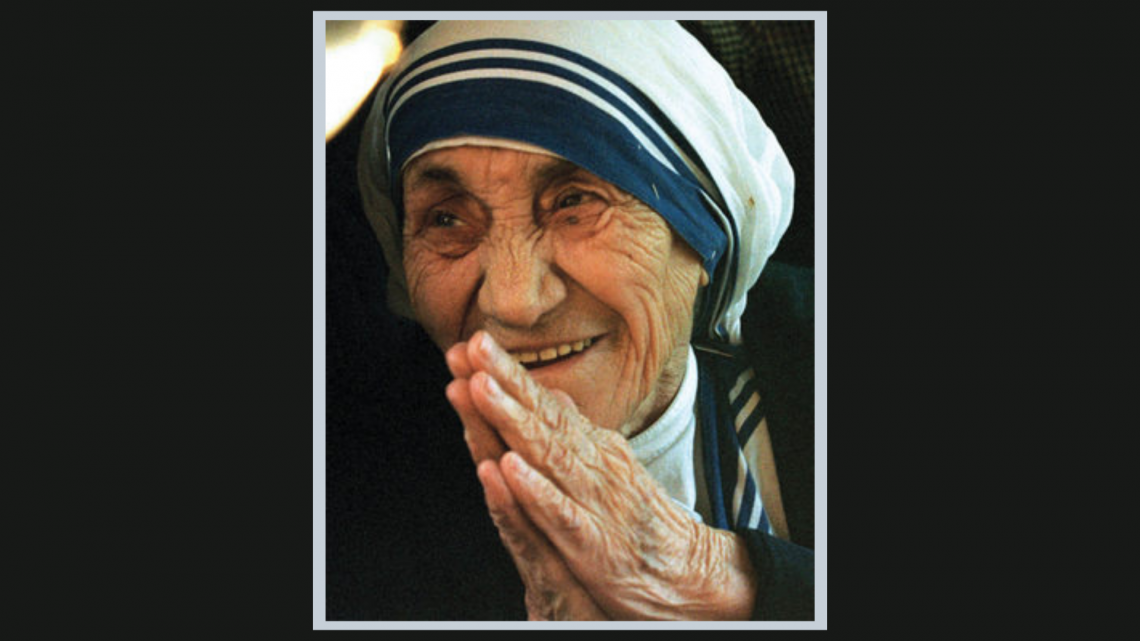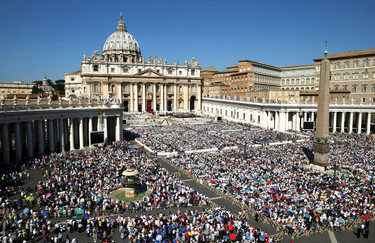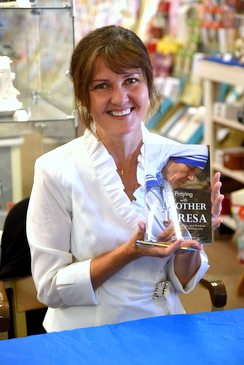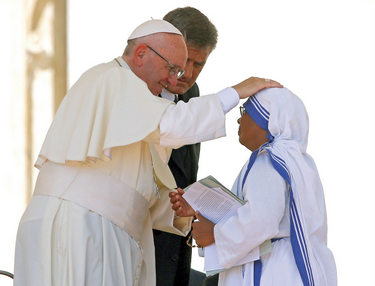November 2016: Doing Small Things with Great Love

During the nearly 50 years that she spent serving the poorest of the poor in India, Mother Teresa was considered by many to be a saint. On September 4, 2016, 19 years after her death, Pope Francis declared her to be one.
"We declare and define Blessed Teresa of Calcutta to be a saint, and we enroll her among the saints, decreeing that she is to be venerated as such by the whole Church,” the pope said during the Rite of Canonization.
Born in Skopje, Albania, in the Ottoman Empire (now Macedonia) on August 26, 1910, Anjezë (Agnes) Gonxha Bojaxhiu considered her baptismal day, August 27, her true birthday. When she was eight, her father died suddenly, leaving her mother to raise three children. Although not wealthy, Drane Bojaxhiu extended an open invitation to the city's poor to dine with her family. She told Agnes, “My child, never eat a single mouthful unless you are sharing it with others.”
Agnes first felt a call to religious life at age 12. When she was 18, she left her home to join the Institute of the Blessed Virgin Mary, known as the Sisters of Loreto, in Ireland. She wanted to become a missionary in India and arrived in Calcutta in 1929 to begin her novitiate. When she took first vows, she wanted to be named after Saint Thérèse of Lisieux but chose the Spanish spelling of Teresa and became Sister Mary Teresa. She made her final profession of vows in 1937, becoming, as she said, “the spouse of Jesus” for “all eternity.” She was first called Mother Teresa while teaching at Saint Mary’s School in Calcutta.
In 1946, while traveling by train from Calcutta to Darjeeling, Sister Teresa experienced what she later referred to as the call within the call.
“I was to leave the convent and help the poor while living among them. It was an order. To fail would have been to break the faith,” she explained.
Two years later, she received permission to begin the Missionaries of Charity. She became an Indian citizen and began wearing the simple cotton sari, for which she became well known. On December 21, 1948, she went into the slums of Calcutta for the first time, visiting families, washing the sores of children, caring for an elderly man lying in the road, and nursing a dying woman.
She did it all with love.
“I am not sure exactly what heaven will be like, but I know that when we die, and it comes time for God to judge us, He will not ask, ‘How many good things have you done in your life?’ Rather, He will ask, ‘How much love did you put into what you did?” she said.
The Missionaries of Charity was recognized as a diocesan religious congregation in 1950. Two years later, Mother Teresa opened Kalighat Home for the Dying, a hospice for the poor. She also opened a home and outreach clinics for those suffering from Hansen’s disease (leprosy). A home for orphans and homeless youth followed. Soon, her work spread across India and then throughout the world. When she died in 1997, 4,000 Missionaries of Charity were present in 123 countries.
“Mother Teresa, in all aspects of her life, was a generous dispenser of divine mercy, making herself available for everyone through her welcome and defense of human life, those unborn and those abandoned and discarded,” Pope Francis said. “She bowed down before those who were spent, left to die on the side of the road, seeing in them their God-given dignity; she made her voice heard before the powers of this world so that they might recognize their guilt for the crime of poverty they created. For Mother Teresa, mercy was the ‘salt’ which gave flavor to her work; it was the ‘light’ which shone in the darkness of the many who no longer had tears to shed for their poverty and suffering.”
The Mass of Canonization brought pilgrims from around the world to Saint Peter’s Square. Among those in attendance was Susan Conroy of South Portland. In 1986, when she was a 21-year-old college student, Conroy traveled to Calcutta to work with Mother Teresa and the Missionaries of Charity. She also resided with the sisters in the South Bronx, served again in Calcutta in 1991, and remained in contact with Mother Teresa throughout her life.
“She dramatically changed the course of my life,” says Conroy of that first trip. “I came back on fire with a love for the Lord and a longing to keep helping people.”
Conroy says what first struck her about Mother Teresa was her deep humility.
“Knowing that she was world famous, I was stunned by how humble she was,” Conroy says. “It’s like she didn’t seem to be aware of it. She was one of the most humble human beings I had ever met in my life.”
Conroy recalls that Mother Teresa would refer to herself as a “little pencil in the hands of God.”
“Meaning, if you like the story of her life, the love story that her life is, you don’t thank the pencil. All the glory is in the hands of God,” says Conroy. “She gave all the glory to God.”
Conroy says Mother Teresa was a woman who didn’t just love Christ but was in love with Him.
“Jesus was always on her mind, always on her lips, and always in her heart. Any conversation I ever had with Mother Teresa, His name came up. She started talking about Jesus because she loved Him and was always thinking of Him.”
She says Mother Teresa saw the face of Jesus in all she met, treating each with dignity and respect.
“When Mother Teresa held a tiny baby in the orphanage, that infant became her whole world. All her love, her care, and her attention went into that little life in front of her as if no one else existed. When Mother Teresa went into the home for the dying and reached out to that emaciated, skeletal human being in front of her, all her love, respect, and attention went into him as she spoke Bengali and held his face in her hands or held his hands in her hands and conversed with him and comforted him. He became the whole world, as if no one else existed. Then, when she had a conversation with Susan Conroy of South Portland, Maine, I became her whole world,” she says. “She treated us all like gold, as if we were precious to her.”
Despite her gentle touch, Mother Teresa was also a fierce defender of the poor and suffering. Monsignor Charles Murphy, who met Mother Teresa while serving as rector of the Pontifical North American College in Rome, recalls the time that she suggested to Pope Saint John Paul II, with whom she was close, that there be a homeless shelter at the Vatican.
“She found a place that she wanted the homeless shelter and reported back to him. He ran it by the bureaucracy, and they said, ‘That’s impossible. That’s an evacuation route from the Paul VI Audience Hall. We need that for emergencies.’ So, being Mother Teresa, she had a marble plaque made designating the spot that she had picked for the homeless shelter, asked the pope to bless it, and that was the end of that. There is a homeless shelter at the Vatican to this day.”
Just 16 months after Mother Teresa’s death, Pope Saint John Paul II waived the usual five-year waiting period and allowed her canonization cause to be opened, the first time that had happened. In 2003, he beatified Mother Teresa, after recognizing as a miracle the healing of an Indian woman with an abdominal tumor. A second miracle, the healing of a Brazilian man, was recognized by Pope Francis in 2015, paving the way for canonization.
Although she is now Saint Teresa, Pope Francis acknowledged that many will spontaneously call her Mother Teresa because “her holiness is so near to us.”
He called her a model of holiness for others to follow.
“May this tireless worker of mercy help us increasingly to understand that our only criterion for action is gratuitous love, free from every ideology and all obligations, offered freely to everyone without distinction of language, culture, race or religion,” he said. “Mother Teresa loved to say, ‘Perhaps I don’t speak their language, but I can smile.’ Let us carry her smile in our hearts and give it to those whom we meet along our journey.”













